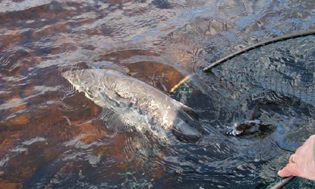District Salmon Fishery Boards and Fishery Trusts are involved in a number of means of increasing salmon and sea trout populations including habitat maintenance and enhancement, mitigation of diffuse pollution, removal of in-stream barriers to migration, removal of invasive non-native species and stocking programmes. However, the simplest means for anglers and ghillies to make a positive and significant contribution to increasing fish populations is catch and release.
The proportion of the rod catch accounted for by catch and release has increased dramatically since 1994, when such information was first recorded in Scotland. Provisional data for the 2012 season demonstrates that 74% of the annual rod catch of salmon was released compared to less than 8% in 1994. This proportion of the rod catch accounted for by catch and release is the highest recorded to date. Crucially, less than 1% of rod caught spring salmon were released in 1994 while 98% were released in 2015. For sea trout the proportion of the rod catch accounted for by catch and release was 79% compared to 8.5% in 1994.
Numerous angling and radio-tracking studies have demonstrated high survival rates and successful spawning for salmon released after capture – up to 100% under certain conditions. However, the longer a fish is out of water, or poorly handled, the less chance it has of survival. Therefore, ASFB, in partnership with the Salmon and Trout association and the Environment Agency have produced guidance on catch and release, in order that salmon and sea trout are given the best opportunity of reaching the spawning redds.
More recently the Atlantic Salmon Federation have produced an excellent video demonstrating techniques of catch and release. This video can be viewed here.


 Follow
Follow